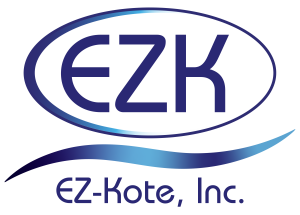Are you still using a combination of cornstarch and talc for your industrial rubber mold release agent? We understand why. Cornstarch and talc are inexpensive, and they’ve worked for your team for many years.
But cornstarch and talc as a silicone rubber mold release agent might not be the best solution for your industrial processes or your company.
Find out how to improve your processes and accelerate your production lines with semi-permanent, water-based mold releases with custom formulations from EZ-Kote.
Water-Based Rubber Mold Releases Are Less Time Consuming
Cornstarch absorbs liquid well while forming a barrier between your SKUs and the mold. However, you need to mix it with talc because cornstarch by itself is too abrasive and might cause defects. Do you purchase these items separately? You’ll need someone on your staff to mix these two ingredients, or you have a mixing machine do it automatically in a separate part of your plant.
Even if you save time with a premade mixture or machine-mixed batch of your cornstarch/talc rubber mold release, it takes time to apply the powder to each SKU, often using oil to coat the mold before applying the powder to ensure it sticks. You likely have to reapply this mold release agent after each SKU.
The beauty of water-based rubber mold release agents is that they don’t have a two-step application process. All you need to do is dilute the concentrated form you receive and store it in your facility. Then, you spray it on evenly and let it cure. The mold release agent is suitable for multiple SKUs rather than just one SKU.
And then, you have to take the time to clean the powder off the part you just made, no matter what you’re making. If you develop an automated cleaning process, you still need someone to inspect each piece, touch it up, and ensure no mold release remains.
You can remove many of these processes with a semi-permanent, water-based rubber mold release. And your SKUs will be cleaner and ready for shipping sooner.
Water-Based Rubber Mold Releases Are Inert Substances
Your team uses cornstarch and talc because both of these substances are chemically inert. They don’t react with the mold, nor do they react with your SKUs. However, these powders can be unwieldy to clean. What if your application process uses too much oil, and the powder gets clumpy? It could gunk up your processes, and the powder might stick to your SKUs even more. Then, they become harder to clean even with your automated cleaning process.
Water-based rubber mold releases are also chemically inert. They have the advantage of going on clear, and they don’t leave a residue behind like your powder. Nor do they clump, making them harder to clean.
Water-Based Rubber Mold Releases Are Cost-Effective
Why are water-based mold releases cost-effective compared to talc and cornstarch? There are several reasons.
Price of the Commodities
Let’s face it. Talc and cornstarch are very inexpensive to buy in bulk. You can buy 1 ton of talcum powder for around $500. A ton of cornstarch is about $1,000. Let’s not talk about how cornstarch prices have skyrocketed over the past couple of years. Unfortunately, because of their widespread use in many industries, talc and cornstarch can vary in price more readily than water-based rubber mold releases.
The prices of water-based rubber mold releases can fluctuate based on supply chains. But they are generally much less volatile than commodities like talc and cornstarch. You’ll also buy less product over time because you only need water and the concentrated mold release agent to handle this process. You won’t have to purchase talc, cornstarch, and oil.
Using Additional Resources to Handle Talc & Cornstarch
Your automated cleaning processes use water, compressed air, and heated air to dry your SKUs to remove the powder.
Imagine a process where you don’t have to do any of that. You won’t waste the electricity needed to power your cleaners, nor will you need to use the water or the air. You could shut down that part of your line with a water-based rubber mold release.
Less Time Spent on the Mold Release Agent
With a rubber mold release agent formulated specifically for your processes, you’ll have less inspection and application time. Plus, you can create more SKUs in between applications.
A water-based rubber mold release reduces your production time to more manageable levels, allowing you to spend more time creating more SKUs while making your processes more efficient.
Talk to Us About Rubber Mold Releases to Replace Your Cornstarch & Talc Powder
EZ-Kote has more than 30 years of experience with water-based rubber mold releases. We can customize a formula for your silicone rubber molds.
Contact EZ-Kote or call (770) 720-1811 for more details. We’ll respond within 24 hours.
